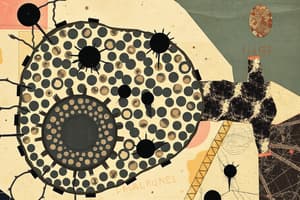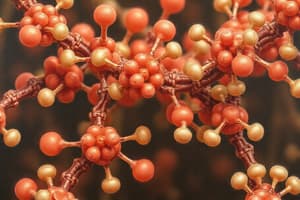Podcast
Questions and Answers
Match the following vocabulary words with the correct definitions.
Match the following vocabulary words with the correct definitions.
Field of view = The area in a microscope you can see Magnification = The amount that an image appears to be enlarged Multicellular = Organism made of many specialized cells working together Unicellular = Organism composed of only one cell Osmosis = Diffusion of water across a semipermeable membrane Semipermeable = Allows some substances through Cell specialization = A cell that has differentiated and has a design related to its function Response = A reaction to something (such as pulling your hand away from heat) Stimuli = An event that produces a response in living tissue
On the blanks to the left of each statement, write the characteristic of life referred to in the statement.
On the blanks to the left of each statement, write the characteristic of life referred to in the statement.
Need Energy = A tomato plant requires sunlight in order to survive Growth = A bean seed develops into a bean plant Reproduction = A bean plant produces a bean seed Produces Waste = A person breathes out carbon dioxide Adapt and respond = You become thirsty after exercise Need energy = A caterpillar eats the leaves of a plant Made of cells = A rabbit is multicellular
What is the correct order when making a wet mount slide of a layer of cells? Place a number (1 being the first step and so on) above each statement in the correct order.
What is the correct order when making a wet mount slide of a layer of cells? Place a number (1 being the first step and so on) above each statement in the correct order.
- Add a drop of water or stain (correct)
- Take a thin layer of cells (correct)
- Lay them on the slide, make sure it lies flat (correct)
- Gently lower the coverslip (correct)
What is the name of the part of the microscope that you look through to view the specimen?
What is the name of the part of the microscope that you look through to view the specimen?
When you switch from low power to high power on a microscope, what happens to the magnification (detail you can see)?
When you switch from low power to high power on a microscope, what happens to the magnification (detail you can see)?
When you switch from low power to high power on a microscope, what happens to the field of view (area you can see)?
When you switch from low power to high power on a microscope, what happens to the field of view (area you can see)?
What is the diameter of the field of view in millimeters under low power?
What is the diameter of the field of view in millimeters under low power?
What is the diameter of the field of view under low power in micrometers?
What is the diameter of the field of view under low power in micrometers?
If the eyepiece magnifies an image 10 times and the high-power objective magnifies 40 times, what is the total magnification?
If the eyepiece magnifies an image 10 times and the high-power objective magnifies 40 times, what is the total magnification?
Match the microscope part with its purpose.
Match the microscope part with its purpose.
Which of the following is NOT part of cell theory?
Which of the following is NOT part of cell theory?
What is the function of the nucleus?
What is the function of the nucleus?
What is the function of the cell wall?
What is the function of the cell wall?
What is the function of the cell membrane?
What is the function of the cell membrane?
What is the function of the chloroplast?
What is the function of the chloroplast?
What is the function of the mitochondria?
What is the function of the mitochondria?
What is the function of the vacuole?
What is the function of the vacuole?
Match the number in the diagram with the correct structure.
Match the number in the diagram with the correct structure.
Muscle cells use lots of energy to move the body. Which organelle below would you expect to find lots of in muscle cells?
Muscle cells use lots of energy to move the body. Which organelle below would you expect to find lots of in muscle cells?
Root cells in plants cannot capture sunlight for photosynthesis. What organelle, usually found in plant cells, would NOT be in root cells?
Root cells in plants cannot capture sunlight for photosynthesis. What organelle, usually found in plant cells, would NOT be in root cells?
Match the cell part with its analogous city component.
Match the cell part with its analogous city component.
The diagram below shows the movement of water in/out of cells in different solutions. Which concentration of water is higher in the solution where the cells are shrinking?
The diagram below shows the movement of water in/out of cells in different solutions. Which concentration of water is higher in the solution where the cells are shrinking?
The egg in the sugar solution would shrink.
The egg in the sugar solution would shrink.
Why did the egg placed in water increase in mass?
Why did the egg placed in water increase in mass?
What kind of membrane does the egg have?
What kind of membrane does the egg have?
Which of the following is NOT part of the levels of organization in the cell?
Which of the following is NOT part of the levels of organization in the cell?
What type of cell protects the body from foreign invaders?
What type of cell protects the body from foreign invaders?
What type of cell sends and receives messages?
What type of cell sends and receives messages?
What type of cell provides rigid support for the body?
What type of cell provides rigid support for the body?
What trend is shown in the graph of the relationship between Simon's heart rate and breathing rate?
What trend is shown in the graph of the relationship between Simon's heart rate and breathing rate?
Flashcards
Field of View
Field of View
The area visible through a microscope.
Magnification
Magnification
The amount that an image appears enlarged.
Multicellular
Multicellular
An organism made of many specialized cells working together.
Unicellular
Unicellular
Signup and view all the flashcards
Semipermeable membrane
Semipermeable membrane
Signup and view all the flashcards
Osmosis
Osmosis
Signup and view all the flashcards
Cell Specialization
Cell Specialization
Signup and view all the flashcards
Response
Response
Signup and view all the flashcards
Stimuli
Stimuli
Signup and view all the flashcards
Nucleus
Nucleus
Signup and view all the flashcards
Cell Wall
Cell Wall
Signup and view all the flashcards
Cell Membrane
Cell Membrane
Signup and view all the flashcards
Chloroplast
Chloroplast
Signup and view all the flashcards
Cytoplasm
Cytoplasm
Signup and view all the flashcards
Mitochondria
Mitochondria
Signup and view all the flashcards
Vacuole
Vacuole
Signup and view all the flashcards
Magnification
Magnification
Signup and view all the flashcards
Field of View
Field of View
Signup and view all the flashcards
Tissue
Tissue
Signup and view all the flashcards
Organ
Organ
Signup and view all the flashcards
Organ System
Organ System
Signup and view all the flashcards
Organism
Organism
Signup and view all the flashcards
Levels of Organization
Levels of Organization
Signup and view all the flashcards
Eyepiece
Eyepiece
Signup and view all the flashcards
Revolving Nosepiece
Revolving Nosepiece
Signup and view all the flashcards
Objective Lenses
Objective Lenses
Signup and view all the flashcards
Diaphragm
Diaphragm
Signup and view all the flashcards
Stage
Stage
Signup and view all the flashcards
Coarse Adjustment Knob
Coarse Adjustment Knob
Signup and view all the flashcards
Fine Adjustment Knob
Fine Adjustment Knob
Signup and view all the flashcards
Study Notes
Cell and Systems Review 1
-
Vocabulary Matching:
-
Field of view: The area in a microscope that can be seen.
-
Magnification: The amount an image appears enlarged.
-
Multicellular: An organism composed of many specialized cells.
-
Unicellular: An organism composed of only one cell.
-
Osmosis: The diffusion of water across a semipermeable membrane.
-
Semipermeable: Allows some substances to pass through.
-
Cell Specialization: A cell's structure adapted to its function.
-
Response: A reaction to a stimulus.
-
Stimuli: Events that produce a response.
-
Characteristics of Life (GRAPE-C):
-
Growth: Development from a smaller to larger size.
-
Reproduction: Producing new organisms.
-
Adapt and respond: Changing behavior in reaction to environment.
-
Produces waste: Excretion of metabolic byproducts.
-
Energy: Requires energy to carry out life processes.
-
Cells: Composed of one or more cells.
-
Wet Mount Slide Procedure:
-
Add water drop to slide
-
Place thin layer of cells
-
Place slide on flat surface
-
Carefully lower coverslip
-
Microscope Parts:
-
Eyepiece: Where you look through
-
Nosepiece: Rotating part to switch objectives
-
Objective Lens: Different powers of magnification
-
Stage Clips: Hold the slide in place
-
Stage: Platform for the slide
-
Light Source: Illuminates the specimen
-
Arm: Supporting part of the microscope
-
Base: Supports the entire microscope
-
Diaphragm: Controls the light passing through
-
Coarse Adjustment Knob: Focus the image in low power
-
Fine Adjustment Knob: Fine tune focus
-
Microscope Magnification:
-
Switching from low to high power increases magnification but reduces the field of view.
-
The diameter of the field of view decreases as magnification increases.
-
Eyepiece magnification times objective lens magnification equals total magnification.
-
Cell Theory:
-
The cell theory states that:
-
All living things are made of cells.
-
Cells comes from other cells.
-
Cells are the functional unit of life. A cell can carry out all functions required for life.
-
Cell Organelles and Function (Refer to diagram for specifics):
-
Nucleus: The control center.
-
Vacuole: Storage.
-
Cell Membrane: The gatekeeper, controls what enters and exits the cell.
-
Chloroplast: Used for photosynthesis (in plant cells)
-
Mitochondria: Converts food to energy
-
Cytoplasm: Holds everything in place inside cell
-
Cell Wall: Rigid support for the cell.
-
Levels of Organization:
-
Cell, Tissue, Organ, Organ System, Organism
-
Organelle in Muscle Cells:
-
Mitochondria are required for energy use.
-
Organelle in Root Cells:
-
Chloroplasts are not necessary as roots do not undergo photosynthesis.
-
Cell Function Related to City:
-
Nucleus (City Hall)
-
Vacuoles (Storage Tanks)
-
Cell membrane (City Gates)
-
Chloroplasts (Power Plant)
-
Mitochondria (Food Processing Plant)
-
Osmosis:
-
Water moves from an area of high water concentration to an area of low water concentration
-
If water concentration outside the cell is higher the cell will expand
-
If water concentration outside the cell is lower the cell will shrink
-
Manipulated & Responding Variables:
-
Manipulated Variable: The factor that is changed in an experiment.
-
Responding Variable: The factor that is measured.
-
Cell in Solution Change:
-
A cell placed in a high sugar solution will shrink.
-
A cell placed in a tap water solution will swell up.
-
Experimental Note:
-
Experimental conditions, particularly if there is a change in weight, should be noted.
Studying That Suits You
Use AI to generate personalized quizzes and flashcards to suit your learning preferences.




